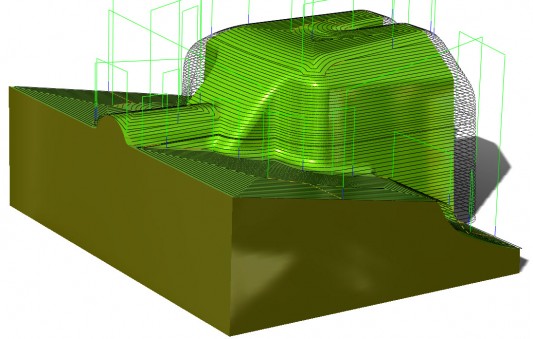New entry-level 3D milling leads the list of new features.
Delcam has announced the 2013 version of Delcam for SolidWorks, an integrated computer-aided milling (CAM) system for SolidWorks. The new release includes a new entry-level 3D milling option, intended mainly as an introductory level program for companies new to 3D machining but will also be useful for users that only have an occasional need for 3D capabilities or that only machine softer materials.

The new entry-level 3D option includes all the 2D and 2.5D strategies available in Delcam for SolidWorks, plus a 3D single-surface strategy for Z-level roughing, with either offset or raster, and finishing with raster, isoline or spiral.
Other new features:
New strategies have been added to the high-speed machining module in Delcam for SolidWorks. Step cutting has been added within area clearance to remove large terraces that can be left on the part when using deeper roughing cuts. Extra toolpaths can now be generated that step back up the terrace with the existing large tool, adding extra cuts at intermediate levels. This results in more material being removed, using the same tool within the same toolpath.
Automatic splitting of finishing between steep and shallow areas of the part has been enhanced with the ability to use the scallop height to control the stepover. Using this value rather than setting a constant stepover distance gives better control of the surface finish.
An “area filter” has been added to both roughing and finishing strategies, to remove small enclosed pockets within the part from the toolpath. Any attempt to cut these areas risks damage to the tool, even though it is mathematically possible to remove the material.
Bottom-up machining for Z-level finishing is now an option, as well as the conventional top-down approach. Delcam says this can be useful when using a ball-nose end mill as it avoids cutting with the center of the tool and so gives a better surface finish and longer tool life.
New five-axis strategies available in Delcam for SolidWorks 2013 include flowline machining between two curves, pencil machining and corner re-machining. These options for simultaneous five-axis machining allow a better surface finish to be achieved as well as ensuring access to more areas within the part in a single set-up.
Smoother five-axis machining options have also been added to. A new look-ahead capability will remove any sudden tool-axis changes during automatic collision avoidance and, instead, ensure that a smooth transition takes place. In addition, the ability to smooth the Azimuth and Elevation axes independently is now available, allowing excessive five-axis movement to be removed. Delcam says these options stabilise the rotary axis movement by maintaining a fixed tool axis as far as possible, thus replacing constant five-axis movement with a series of 3+2-axis segments having full five-axis transitions between them.





